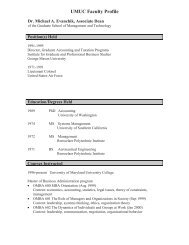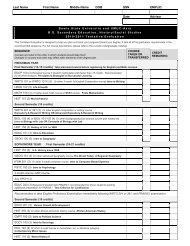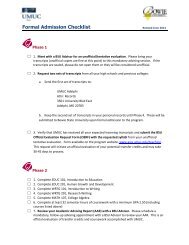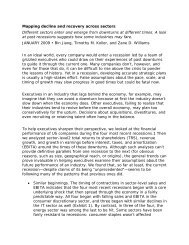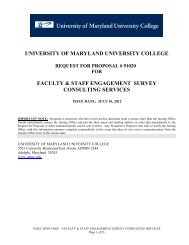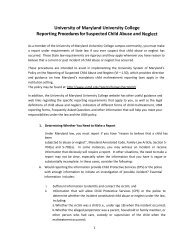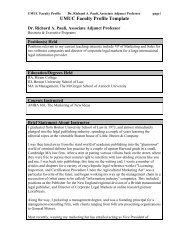A+B. Intro_SJ.1 - University of Maryland University College
A+B. Intro_SJ.1 - University of Maryland University College
A+B. Intro_SJ.1 - University of Maryland University College
You also want an ePaper? Increase the reach of your titles
YUMPU automatically turns print PDFs into web optimized ePapers that Google loves.
B I OT 610 In t roduction to Bi o i n f o rmatics (3)<br />
( Formerly BIOT and BTMN 646.) Efficient experimental techniques<br />
have led to an exponential growth <strong>of</strong> data in biotechnolo<br />
g y. Today the emphasis is switching from the accumulation <strong>of</strong><br />
data to their analysis and interpretation. Computational tools for<br />
classifying sequences, large data bases <strong>of</strong> biological information,<br />
computationally intensive methods, new algorithms, and machine<br />
learning unite to extract new concepts. This is the domain <strong>of</strong><br />
bioinformatics. Sp e c i f i c a l l y, bioinformatics includes new sophisticated<br />
DNA, RNA, and protein sequence analyses and pattern<br />
recognition and DNA computing, but also more traditional<br />
mathematical modeling, Bayesian probability and basic algorithms,<br />
machine learning and neural networks, and Ma rk ov<br />
models and dynamic programming. Bioinformatics covers many<br />
subjects, among the most important <strong>of</strong> which are the analysis <strong>of</strong><br />
m a c romolecular sequences, the analysis <strong>of</strong> tridimensional stru c-<br />
t u res, the analysis <strong>of</strong> phylogenic relationships, and the analysis <strong>of</strong><br />
genomic and proteomic data.<br />
B I OT 613 Statistical Processes for Biotechnology (3)<br />
Pre requisite: Knowledge <strong>of</strong> basic statistics. This class focuses on<br />
Bayesian statistics, Markov processes, and information theoric<br />
indices. These statistical tools can be used to analyze inheritance<br />
patterns (dominance, recession, sex linkages, etc.), sequence<br />
homology, and the presence <strong>of</strong> motifs in sequences. A number<br />
<strong>of</strong> concepts (including information content, mutual information,<br />
long-range correlation, repeats, and Fourrier analysis) will<br />
be introduced. Linguistic methods will be evaluated.<br />
BIOT 615 Relational Database Systems (3)<br />
(Also listed as CSMN 661.) This course introduces the fundamental<br />
concepts necessary for the design, use, and implementation<br />
<strong>of</strong> relational database systems. The course stresses the<br />
fundamentals <strong>of</strong> database modeling and design, the languages<br />
and facilities provided by database management systems, and the<br />
techniques for implementing relational database systems. The<br />
course has an emphasis on relational databases, but includes the<br />
network and hierarchical data models. Semantic modeling and<br />
functional data modeling concepts are also included. Various<br />
database design techniques, implementation concepts, and techniques<br />
for query optimization, concurrency control, recovery,<br />
and integrity are investigated. There will be an online laboratory<br />
component for this course.<br />
BIOT 616 Data Structures and Algorithms (3)<br />
(Also listed as CSMN 614.) This course introduces the definitions,<br />
implementations, and applications <strong>of</strong> the most basic data<br />
structures used in computer science, including the concept <strong>of</strong><br />
abstract data types. The course also introduces the basic formalism<br />
and concepts used in the analysis <strong>of</strong> algorithms and in algorithm<br />
design. The relative efficiency <strong>of</strong> the algorithms studied is<br />
estimated by informal application <strong>of</strong> these ideas. The algorithms<br />
and data structures discussed include those for sorting, searching,<br />
graph problems, dynamic programming, combinatorial<br />
search, and others.<br />
BIOT 617 Advanced Bioinformatics (3)<br />
Students are given the basic programming tools for performing<br />
bioinformatic analyses in both the UNIX and MS DOS/<br />
Window environments. The class focuses on the use <strong>of</strong> Perl and<br />
Bioperl as the basic programming tools. Students develop and<br />
practice basic programming skills on such problems as codon<br />
usage/bias, open reading frame, CpG islands detection, and<br />
gene identification.<br />
BIOT 640 Societal Issues in Biotechnology (3)<br />
( Formerly BTMN 640.) An ove rv i ew <strong>of</strong> the early history, modern<br />
developments, and bioethical issues <strong>of</strong> biotechnology is provided.<br />
Managerial views <strong>of</strong> the commercialization <strong>of</strong> technology,<br />
legal issues, biohazards, and the evolution <strong>of</strong> biotechnology as a<br />
function <strong>of</strong> human interventions are presented. St ress is on the<br />
need for public scrutiny and the role <strong>of</strong> governmental re g u l a t o ry<br />
agencies in re s e a rching, developing, and commerc i a l i z i n g<br />
b i o t e c h n o l o g y.<br />
BIOT 641 Commercializing Biotechnology in Early-Stage<br />
Ventures (3)<br />
(Formerly BTMN 641.) This course focuses on methods for<br />
planning and organizing biotechnology ventures. The elements<br />
<strong>of</strong> a business plan are considered, as are methods for assessing<br />
various needs, such as capital, personnel, t e c h n o l o g y, and marketing.<br />
Ap p roaches to marketing technology and developing joint<br />
ventures are emphasized. Advantages and disadvantages <strong>of</strong> forming<br />
international ventures are weighed. The importance <strong>of</strong> maintaining<br />
relations with external constituents is discussed, as is the<br />
need for managing public awareness.<br />
w w w. u m u c . e d u / g r a d<br />
Un i versity <strong>of</strong> Ma r yland Un i versity <strong>College</strong> | 121 |





